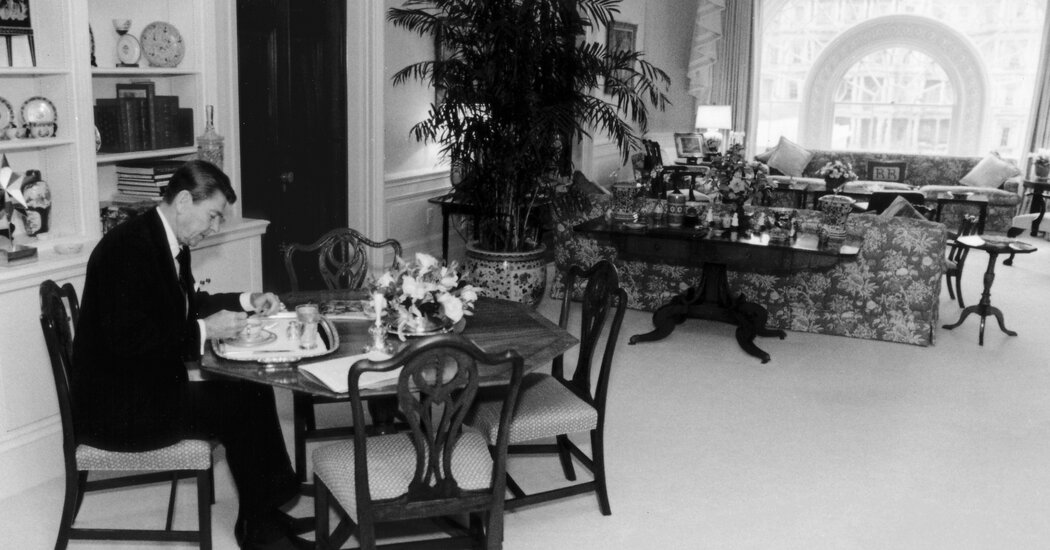I first went into the White House when my father, Ronald Reagan, was inaugurated in January 1981. It was afternoon and I had been assigned an inaugural ball to attend later. A ball gown was waiting for me; so was a hairdresser who insisted that my hair had to be pinned up. I was the rebellious first daughter who didn’t want to be first daughter. I wanted my life back — a life that didn’t have armed agents following me and reporters writing about me, a life with no ball gowns at all.
Swept up in my own personal drama, I was blind to the much greater drama of my surroundings, the history brushing past me in the White House’s long hallways. (When my family got a Cavalier King Charles spaniel named Rex, he stood near the Lincoln Bedroom barking his little head off at no one, in what my father insisted was an encounter with Lincoln’s ghost. I waited in vain for my own encounter with the ghost, so I could complain to him about all the intrusions into my life.)
I visited the White House many more times over the next eight years, and though I could see well enough that it was a nice building, I was always counting the hours until I could leave.
Then my father left office, and it wasn’t until many years later, after his death, that I returned to the White House. My family was in Washington for the memorial, and my brother, his wife and I were offered a tour to fill the long empty morning before the service. As soon as we entered the building, through the East Wing, I felt history fold itself around me.
Everything had meaning — the feel of our footsteps on the marble floors, the thick hush amid constant activity. Our guide talked about how Franklin Roosevelt added to the East Wing in 1942, how Rosalynn Carter was the first first lady to have a formally dedicated office there. I walked through the White House as if I had never been there before because, in a way, I hadn’t. I hadn’t been present and open to the echoes of the past, to all that was left behind from those who made their mark on America, who walked those same floors, breathed that same air, looked out the same windows. I was awe-struck.
The images we’ve now all seen of the East Wing being demolished are heartbreaking. Over the centuries, many presidents have altered the White House, and certainly older buildings need to be updated and repaired. But this is complete destruction.
Among certain jaded observers, there’s been a strain of chatter dismissing the damage, saying the East Wing was never all that architecturally distinguished. But it was not just a building made of brick and plaster; it was the people’s house, a building suffused with the spirit of the ideals that built it. It was a building that invited you to look beyond your own life, your own reality, to something bigger, a huge story we all inhabit. To stand in such a place makes you feel small, yet also larger than just yourself. It makes you aware of the continuum of history in a way that feels akin to sacredness.
And now the East Wing is gone. I’m grateful that I had that chance to re-enter the White House and see it through more open eyes, experience it without my own resentments getting in the way. Now no one else will get to walk across that threshold and feel the richness of that history brush past them. It was where Eleanor Roosevelt walked. It was where Jacqueline Kennedy planned the Rose Garden.
We silence so much when we tear down places that are there to teach us, inspire us, humble us. Ghosts and memories drift away in the dust, the wreckage, and we are all poorer as a result.
Patti Davis is the author of “Dear Mom and Dad: A Letter About Family, Memory and the America We Once Knew.”
The Times is committed to publishing a diversity of letters to the editor. We’d like to hear what you think about this or any of our articles. Here are some tips. And here’s our email: [email protected].
Follow the New York Times Opinion section on Facebook, Instagram, TikTok, Bluesky, WhatsApp and Threads.
The post When My Family Lived in the White House I Resented It. Now I Mourn It. appeared first on New York Times.




